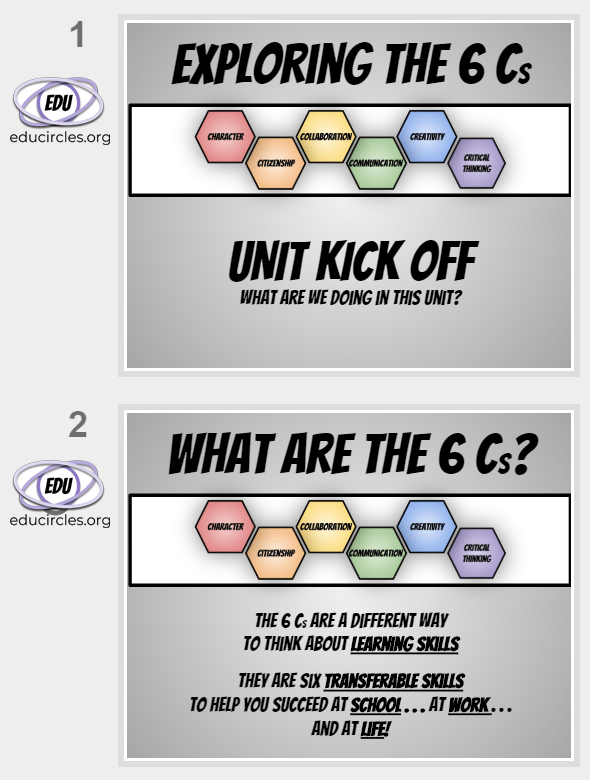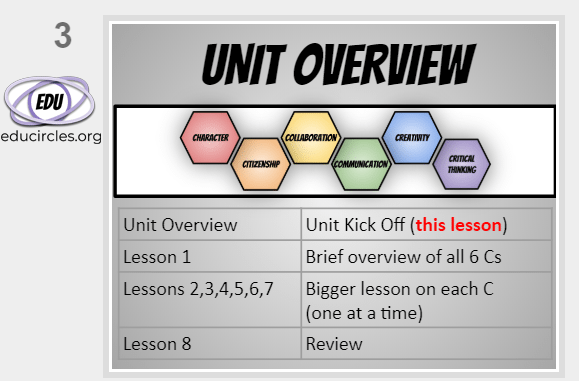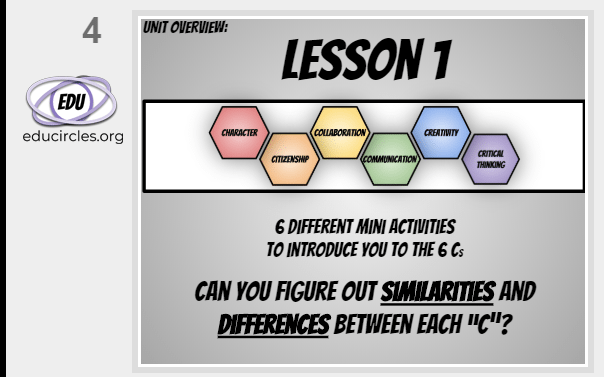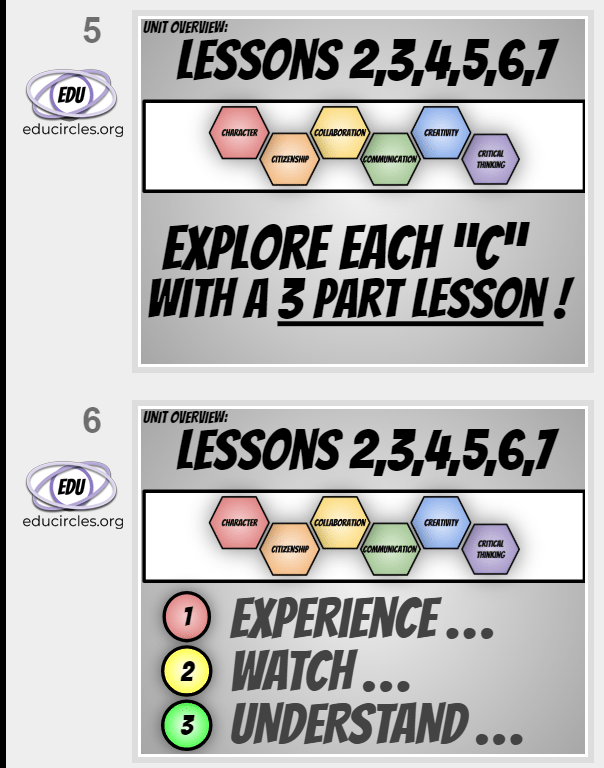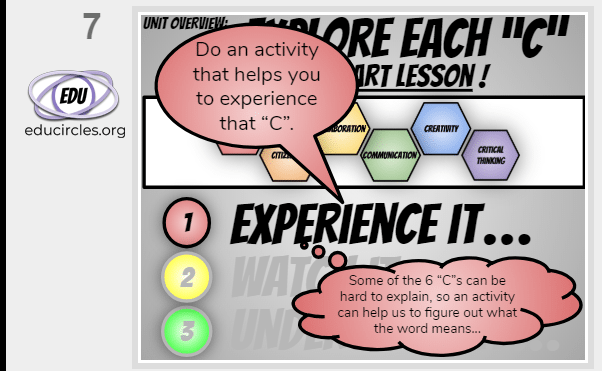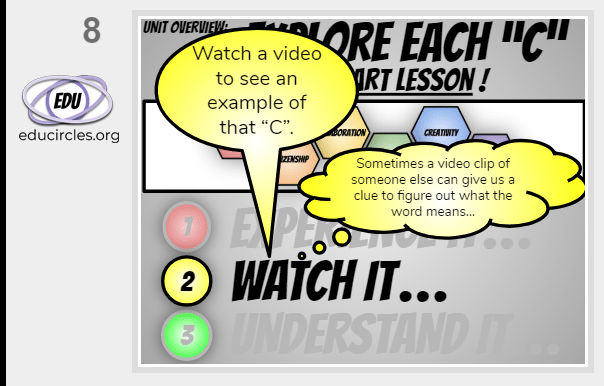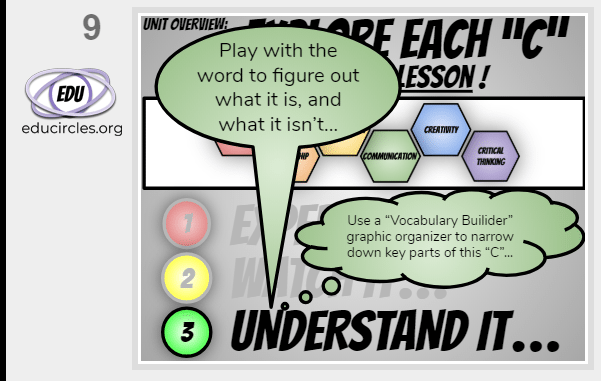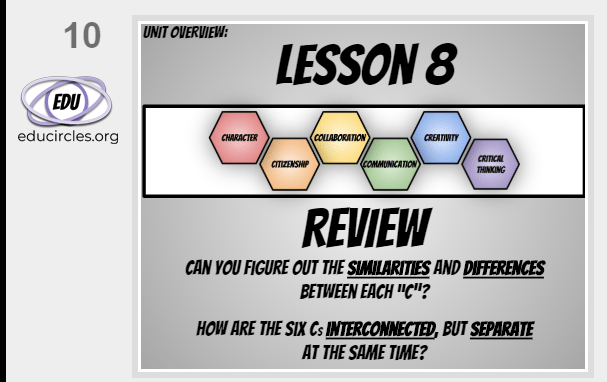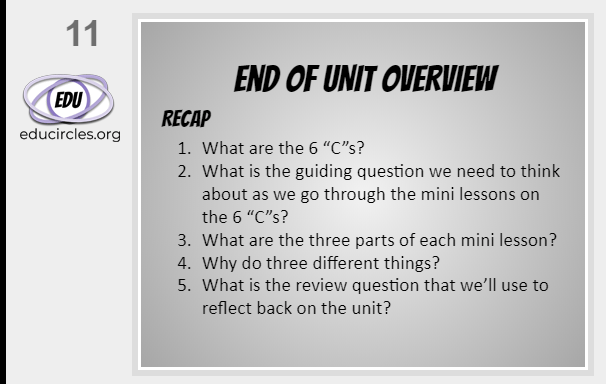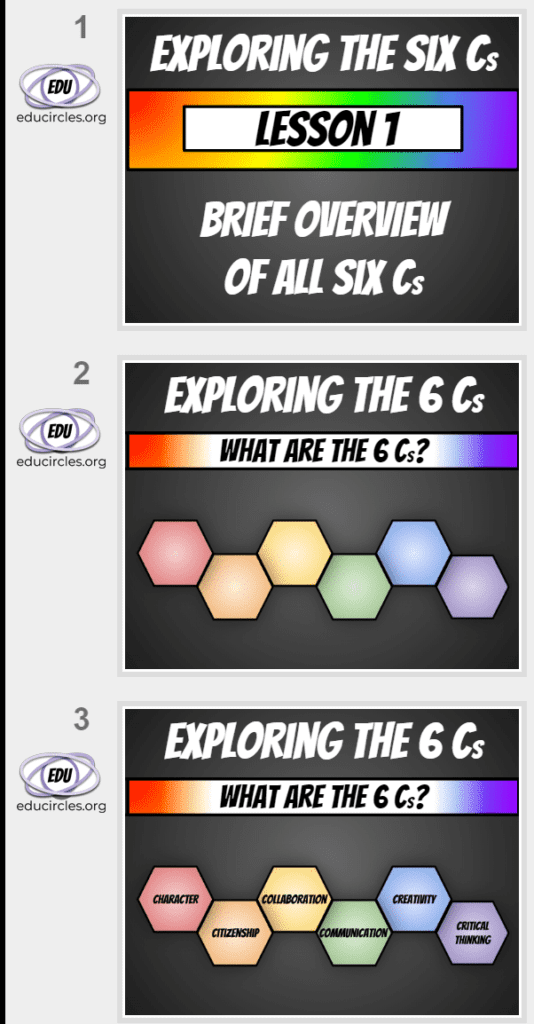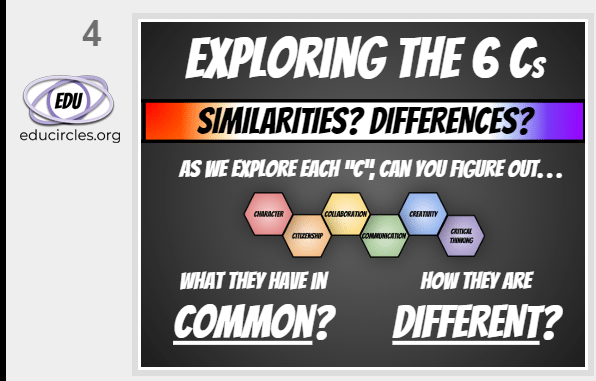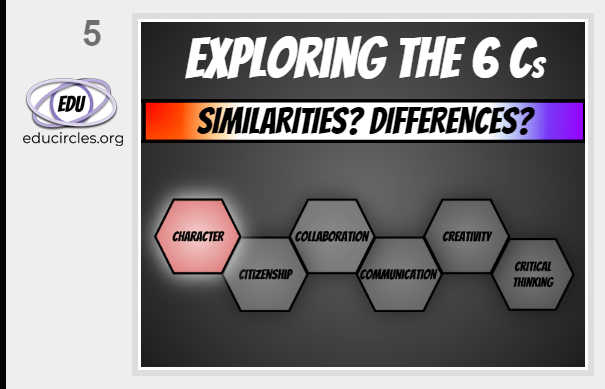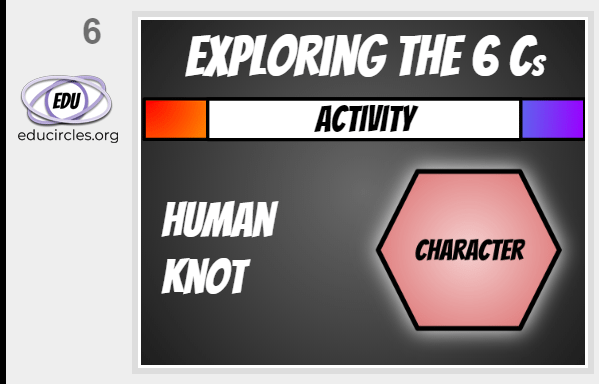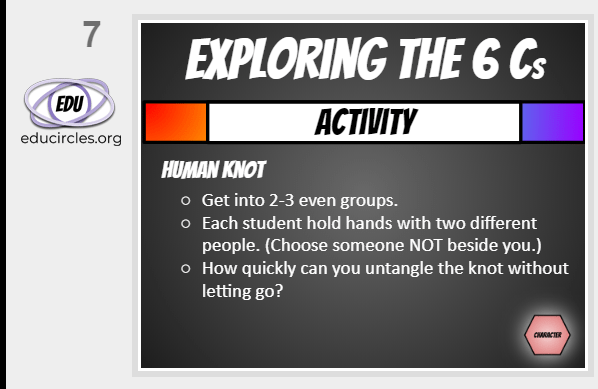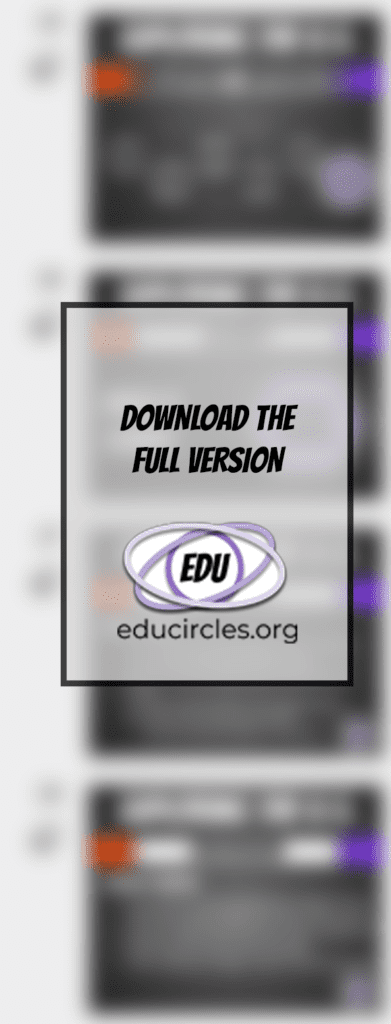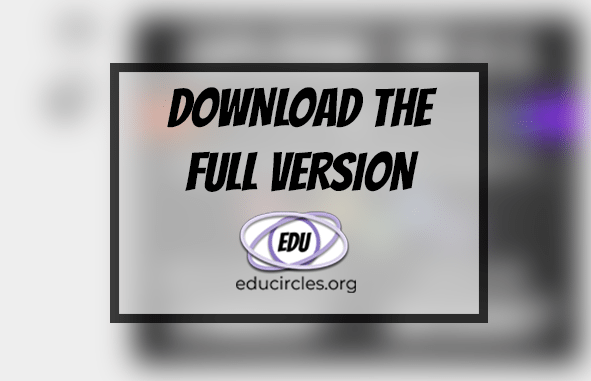6 C’s of Education / 21st Century Competencies / Growth Mindset Lessons –
Social Emotional Learning SEL that isn’t babyish!
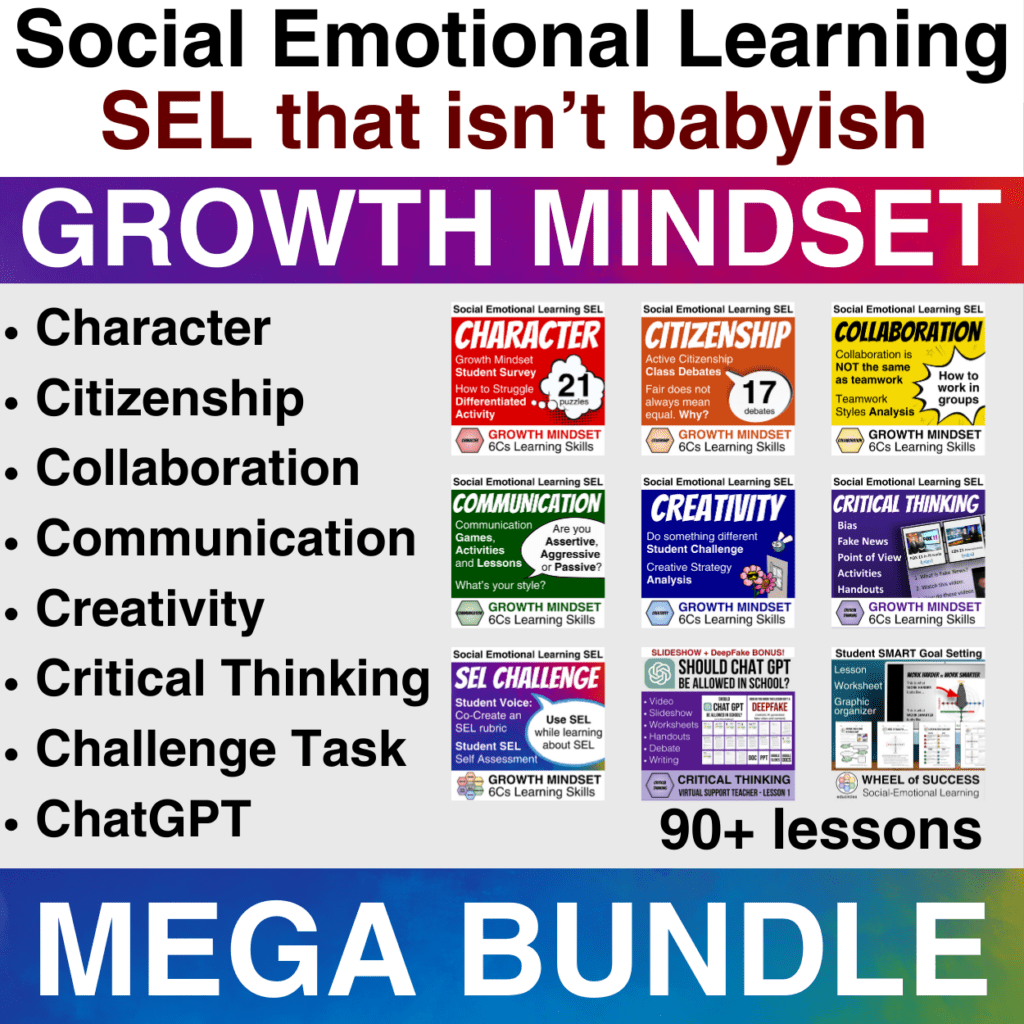
6 Cs of Education – Mar 1, 2024 Update – Social Emotional Learning SEL that isn’t babyish. Use this Growth Mindset / 21st Century Competencies Bundle to shift student attitudes towards learning.
Here are 90+ lesson plans you can use throughout the year to teach Social Emotional Learning (SEL) in a meaningful way for older students.
No cheesy videos for your students to roll their eyes at. This is real-world social emotional learning.
Explore the 6 Cs of Education, Social-Emotional Learning Skills, and 21st Century Competencies.
Social Emotional Learning that isn’t Babyish!
The pandemic put a spotlight on student mental health and resilience.
The challenge is that a lot of Social Emotional Learning (SEL) programs are targeted towards younger grades.
Here are a set of 90+ lessons developing Social Emotional Learning Skills using real world examples.
(No fake acting, cheesy videos in here!)
These 21st Century Learning Skills (Character, Citizenship, Collaboration, Communication, Creativity, and Critical Thinking) help us overcome academic challenges, as well, as personal challenges, temptations, and struggles.
Hello, ChatGPT…
How to help students learn for themselves in a World with ChatGPT
In today’s educational landscape, ChatGPT has emerged as a powerful learning tool, as well as a potential means for cheating. However, it is just the beginning of a new era.
Very soon, Google is set to unveil Project Magi, their own version of ChatGPT, essentially incorporating Artificial Intelligence into Google Search.
Nevertheless, it’s crucial to acknowledge that the current Google Search has displayed sexist tendencies due to human bias, as evident in this ChatGPT lesson. Therefore, it’s reasonable to assume that ChatGPT may also develop discriminatory behaviors owing to human biases.
Now, let’s explore some responses to ChatGPT that are likely to fall short:
- Merely asking students not to plagiarize or cheat using ChatGPT won’t work. It triggers the “don’t think about pink elephants” effect, ultimately leading them to focus on the forbidden act.
- Implementing an outright ban on ChatGPT is not a sustainable solution. Students will inevitably find ways to access it on personal devices or from home, rendering the ban ineffective.
- Encouraging students to “think critically” about information obtained from ChatGPT alone is inadequate. Even when we acknowledge the need for critical thinking with information from Google Search, the example of the sexist result demonstrates that biased information might elude our scrutiny.
The truth is, if we fail to comprehend how to use ChatGPT as a tool effectively, we put ourselves at a competitive disadvantage.
(Would your students agree? Check out this segment of the ChatGPT video lesson at 9:20.)
- Think about the difference between obtaining information from an encyclopedia at the library versus utilizing the internet at home.
- Or, what about the difference between harvesting grain by hand versus using a combine harvester tractor?
- How about building a house with a hammer versus a nail gun?
To address the challenges posed by ChatGPT, we need to embrace change. And, that’s scary!
What if we prioritize developing social-emotional learning skills and 6Cs Competencies among our students?
- Foster CHARACTER learning skills:
- Encourage self-awareness of their abilities, strengths, and needs.
- Promote self-control to make ethical decisions, including abstaining from using ChatGPT unethically.
- Cultivate perseverance, grit, and tenacity to do what is right.
- Nurture resilience to bounce back stronger when faced with setbacks.
- Cultivate CITIZENSHIP learning skills:
- Empower students to become active contributors to their communities, both physical and digital.
- Encourage them to stand up for others and voice their concerns when they identify wrongdoing or misdirection.
- Educate students about the inner workings of ChatGPT, emphasizing the risks associated with curated information and personalized results.
- Promote COLLABORATION learning skills:
- Envision ChatGPT as a robot companion and explore how to develop new understandings collaboratively, transcending initial knowledge boundaries.
- Engage students in activities where ChatGPT serves as a revising and editing partner in a creative writing class, fostering genuine collaboration that sparks the creation of novel ideas.
- Enhance COMMUNICATION learning skills:
- Teach students how to effectively convey their thoughts, particularly in emotionally charged situations.
- Enable them to be assertive rather than aggressive, passive, or passive-aggressive.
- Demonstrate how ChatGPT can assist in crafting clear messages, and encourage students to pose questions to ChatGPT to improve their communication skills.
- Foster CRITICAL THINKING learning skills:
- Develop students’ ability to make well-informed decisions using reliable information.
- Encourage active pursuit of information that supports opposing viewpoints.
- Introduce criteria-based decision-making techniques.
- Emphasize that evaluating information from ChatGPT is no different from scrutinizing information from social media, mainstream media, friends, or family. Explore this aspect in the ChatGPT video lesson at 52:42.
- Cultivate CREATIVITY learning skills:
- Highlight that creativity extends beyond artistic talent, encompassing the generation of new ideas and innovative solutions.
- Encourage students to connect their life experiences and knowledge in novel ways.
- Surprise your students by showcasing ChatGPT’s ability to engage in creative writing. For instance, requesting ChatGPT to deliver a persuasive speech from the perspective of a pet dog. Explore this in the video lesson at 13:55.
It’s important to note that this bundle does not explicitly focus on ChatGPT, except for the UNIT KICK-OFF lesson: “Should ChatGPT Be Allowed In Schools (or is this cheating?).” This aspect means the resources in this bundle are timeless and applicable beyond ChatGPT.
In reality, ChatGPT is merely one of the obstacles our students will encounter in their educational journey.
Change is an inevitable part of life, and learning how to adapt to change is a superpower.
By equipping students with the ability to learn and adapt, we empower them to navigate any future challenges they may face. (Discover more in the ChatGPT video introduction lesson at 2:54.)
By not fixating on ChatGPT in every lesson, this resource becomes a versatile tool that can be used every year, regardless of the next global issue that arises.
Prepare your students for a future where learning skills go hand in hand with the tools at their disposal.
Together, let’s embrace the potential of ChatGPT while nurturing the essential skills that will empower our students to thrive in the 21st century.
Disagree with my take on ChatGPT and Education?
Don’t worry, you’re not alone.
Lots of people think it’s absolutely wrong to allow ChatGPT in schools.
- Leave a comment about why I’m wrong (or right) on this facebook post.
- Tell me if this experiment can detect a liberal bias in ChatGPT.
The world has changed. Have we changed the way we teach?
Let’s talk about social-emotional learning skills and life skills to help us deal with a changing world.
You can call them:
- 6 C’s of Deep Learning,
- 21st Century Competencies,
- New Pedagogies for Deep Learning (NPDL), or
- Social-Emotional Learning (SEL) skills.
Basically, they’re transferrable skills, competencies, and attitudes that help students survive and thrive.
Plus, as you teach and explore with your students, you might find the 6Cs shift the way you view life.
(The 6 Cs of Education / NPDL helped save my life during some dark times.)
Why do we need these 6 Competencies in Education?
Because things constantly change at school, in relationships, and in life. (Covid and Russia’s war in Ukraine are some recent examples.)
SEL is just good teaching. Teachers have done it for years, no matter what you call it.

Here’s a bundle of resources to help you save prep time.
Edit the files to fit the terms used at your school.
(Google Docs, Google Slides, Microsoft Word, Microsoft Powerpoint)
Which of these phrases are used in your learning communities?
- Social Emotional Learning (SEL)
- Growth Mindset vs Fixed Mindset
- The 6 Cs of Education (or 4 Cs or 7 Cs…)
- New Pedagogies for Deep Learning
- 21st Century Competencies…
If you’re doing New Pedagogies for Deep Learning, save hours of prep by introducing your students to NPDL with this Growth Mindset 21st-Century Skills Mega Bundle.
This is a great starting point for conversation.
It’s not the endpoint for your NPDL journey.
What are the 6 C’s of Education for the 21st Century?
The Six Cs of Education are a set of core competencies that students need to survive and thrive in an ever-changing global world.
The 6 Cs are Character, Citizenship, Collaboration, Communication, Creativity, and Critical Thinking.
Education leaders feel “a small number of academic and personal/interpersonal qualities and capabilities” are key to helping students.
You can read more about the 6 Cs and New Pedagogies for Deep Learning in Michael Fullan & Geoff Scott’s whitepaper here: Education Plus – A Whitepaper, July 2014.
The world has changed.
The world is not an easy place.
- People disagree.
- Things can be unfair.
- Life can be tough.
- ChatGPT has changed the game.
- We need to create solutions that we’ve never thought of before…
And that’s just in school staff meetings!
(Hello, staffing assignments, school covid policies, office politics, bureaucracy, educracy, standardized tests, toxic positivity gaslighting, and worrying about ChatGPT being the ultimate cheating tool…)
The real world outside of the class is an even crazier place!
It seems every day brings another opportunity to explore how 21st Century Competencies can help our students get through tough times.
- The pandemic showed us how quickly things can change.
- George Floyd and a spotlight on racism remind us that the world does not treat everyone the same.
- The war in Ukraine has global impacts.
- Not everyone agrees. January 6, 2021 and Freedom Convoy 2022 are clear examples of this.
- ChatGPT only launched in November 2022, and already it’s changed things. Should schools allow ChatGPT in the classroom? Or, is this an epic mistake?!
Does the way we teach empower students with skills, attitudes, and mindsets to deal with the unknown?
Are we teaching students to become good workers?
TEACHING TIP: Before we immediately jump on the schools-are-outdated-and-need-individual-learning bandwagon, check out this counterpoint of view about the Invented History of the Factory Model of Education.
Is algorithmic work-at-your-own-pace individual learning the solution?
Maybe. Maybe not.
…we’ve invented a history of “the factory model of education” in order to justify an “upgrade” – to new software and hardware that will do much of the same thing schools have done for generations now, just (supposedly) more efficiently, with control moved out of the hands of labor (teachers) and into the hands of a new class of engineers, out of the realm of the government and into the realm of the market.
Source: Hack Education: The History of the Future of Education Technology
The world continues to change.
Change is hard. It seems like every day, the rules are changing:
- online learning – when we had to figure out how to use Zoom, Google Meet, Skype and other video conferencing software
- in-person learning with physical distancing – when we’re back in our classrooms, but we have to stay 2 meters / 6 feet apart!?
- now, things are “back to normal” but, are they? ChatGPT is a new robot friend who seems neutral… but can give silly or incorrect answers that lead us in the wrong direction.
It’s hard for us as adults.
But it’s equally hard for students. Maybe even harder. Do students have less power and control over their lives compared to adults?
Now is a great time to teach transferable life skills as we teach “the curriculum.”
The 6cs of Deep Learning and 21st Century Learning isn’t just for homeroom or advisory teachers.
It’s for everyone teaching elementary, middle, or high school.
Life skills are something we can consciously embed into our day-to-day teaching. (Not just the teachable moments when they arise – although those are important, too!)
And these transferrable skills help us with overcoming challenges: like the current pandemic, or you know, the next global challenge…
Check out the Mega Bundle to save you time and money.
Want to know why I’m so passionate about teaching 21st Century Learning Skills? Because they helped save my life.
By the way, if what you’ve read so far really speaks to your way of teaching you should consider becoming an SEOTpreneur.
- Having a side gig as a teacher (i.e. selling teaching resources) is the ultimate authentic 21st century learning task for teachers.
- It’s not easy. But, I believe we can achieve pedagogical and cultural paradigm shift through teacher entrepreneurial adventure.
- Curious? Watch this video.
Teaching in the “new normal”
Since we’re in a “new normal”, let’s wonder how else we could prepare our students for the future.
Watch the video.
Are our students ready for the 21st Century?
We live in a global world connecting people and places in ways that we can’t even imagine.
(And, that’s even after seeing what the pandemic can do!)
Life today is different from when we were growing up.
I remember…
- life before the internet.
- dial-up internet and dot-matrix printers.
- a world before social media. (Even before MySpace!)
- when cell phones were gigantic bricks
- before you could ask your robot friend ChatGPT to summarize a text or do some creative writing for you…
And I’m in my 40s. I taught in a grade 8 classroom for over 12 years.
If I look around the staff room, there are teachers older than me and teachers younger than me.
- Some of my teaching colleagues tell me about a world where television was black and white.
- Some of my teaching colleagues never had to watch a TV show because it aired at a specific time. (This was before Wandavision.)
Teachers, like everybody else, have unconscious bias.
Unconscious bias is a thing.
It’s like an invisible lens that colors the way we see things. (Check out lessons 3-6 in this critical thinking package.)
Teachers are humans. We teach:
- what we know
- from when we grew up,
- and, we don’t want to change. (Most people don’t.)
But, we can also recognize our unconscious bias!
We can be lifelong learners. We can work on the skills and competencies that our students need to have to thrive in the global unknown.
We got this!
Let’s teach using the 6 Cs of Education.
- Instead of focusing on only teaching knowledge and content for tests,
- let’s focus on teaching transferable life skills and a growth mindset to explore the curriculum.
It’s a subtle difference, but it makes all of the difference.
I guess the real question is how might we help our students build a foundation to deal with the unknown?
(As opposed to how might we help students to excel at memorizing definitions and passing standardized tests?)
What are 21st Century Global Competencies?
21st Century Global Competencies and 21st Century Global Skills revolve around preparing our students to thrive in life (and not just survive or get by.)
Although we often use 21st Century Competencies and 21st Century Skills interchangeably, some people who have spent a lot of time thinking about this issue want us to know that Competencies and Skills are different things.
The Organisation for Economic Co-operation and Development (OECD) is an international organization that works to build policies that result in better lives.
They have an executive summary defining and selecting key global competencies. Here’s how they define 21st Century Global Competencies:
A competency is more than just knowledge and skills. It involves the ability to meet complex demands, by drawing on and mobilising psychosocial resources (including skills and attitudes) in a particular context. For example, the ability to communicate effectively is a competency that may draw on an individual’s knowledge of language, practical IT skills and attitudes towards those with whom he or she is communicating.
OECD, The Definition and Selection of Key Competencies Executive Summary. Link
Bottom Line: We need to do more than just teach content. We also need to think about how are we helping prepare students to be successful in life – whether that’s in a competitive global reality, or in our local communities.
So, it’s not just what we teach, but how we teach – and thinking about the “soft skills” that work both in the classroom and outside in the “real world”.
(Want an authentic 21st-century challenge for teachers? Try selling on TpT. Then wonder how to bring in a real-world challenge to teach “the curriculum” to your students.)
At my school, we don’t call them 6 Cs of Education. We call them something else.
Yup. I hear you.
Potato, potato, tomato, tomato. (Check out this 6 C’s Challenge Task that addresses this very issue.)
In my school board, the Ottawa Carleton District School Board, we called them the 6 Cs of Education, “NPDL” (New Pedagogies for Deep Learning,) or 21st Century Competencies.
But other places refer to them as 4Cs, 5Cs, or 7 Cs of Education.
There are differences and similarities.
(The province of Ontario was moving towards redesigning learning skills on their report card to reflect these six competencies. In 2015, the Ontario government published a fantastic document called the 21st Century Competencies Foundation Document for Discussion. (The PDF is posted on Edugains). You can also check out a 2017 draft description of transferable skills that would have had teachers reporting on the 6 Cs.)
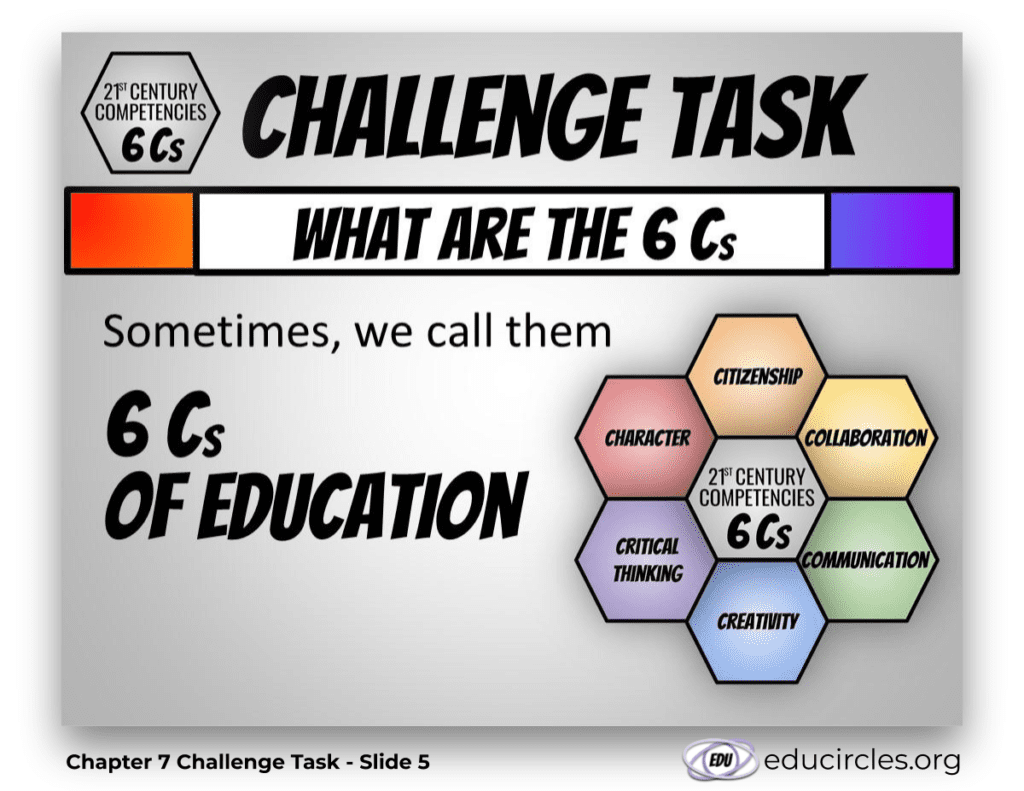
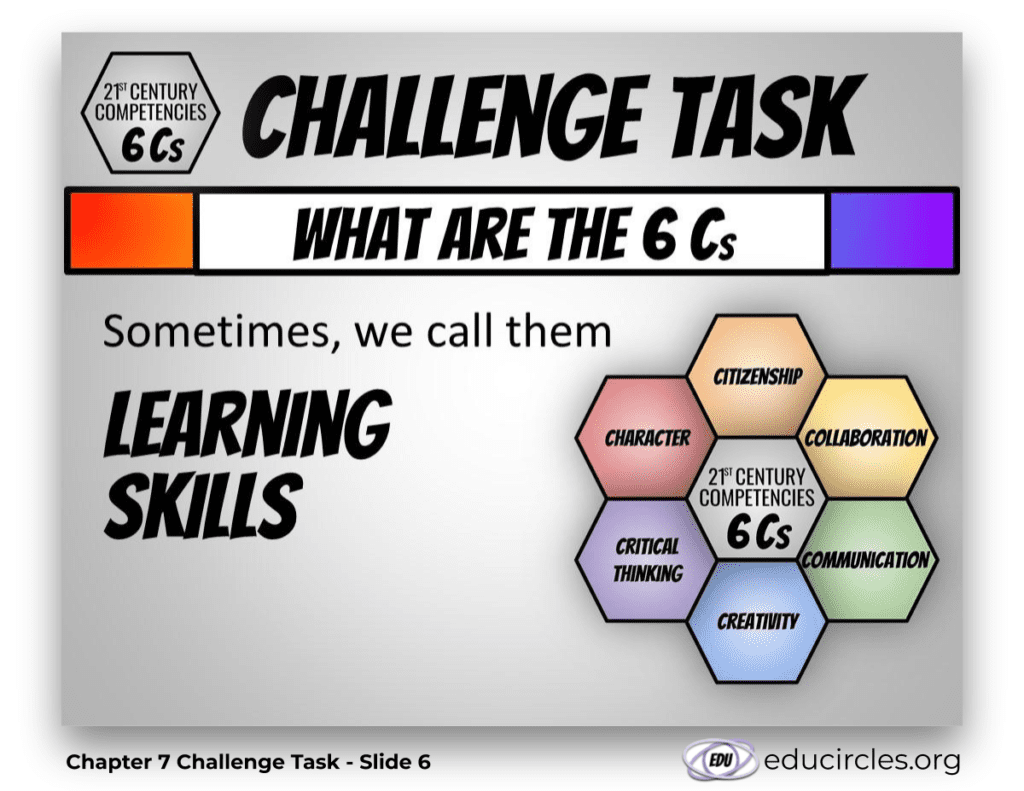
But, depending on where you are, you might know these 6Cs as
- 21st Century Global SKILLS or
- 21st Century Global COMPETENCIES.
(Same, same, but different.)
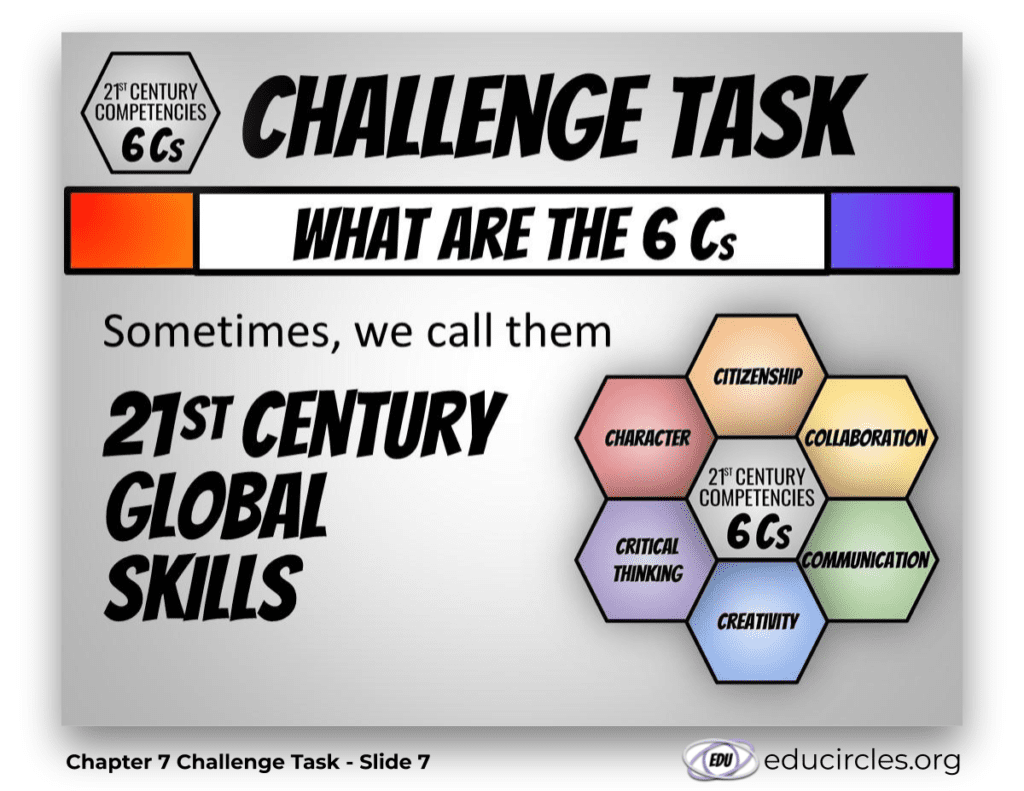
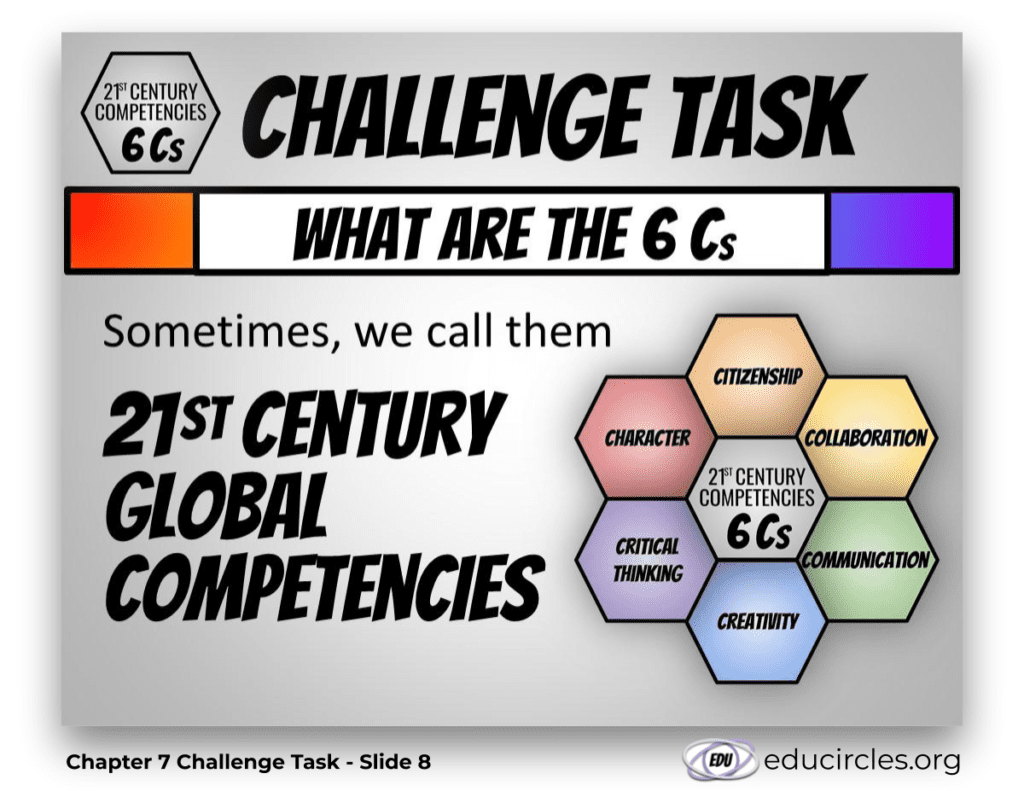
In your part of the world, you may be teaching your students about the
- 4 Cs of 21st Century Learning (Collaboration, Communication, Creativity, Critical Thinking)
- or the 7 C Skills (Cross Cultural Understanding, Career and Learning Self-Reliance, Computing and ICT Literacy, Critical Thinking and Problem Solving, Creativity and Innovation, Communication, Information and Media Literacy.)
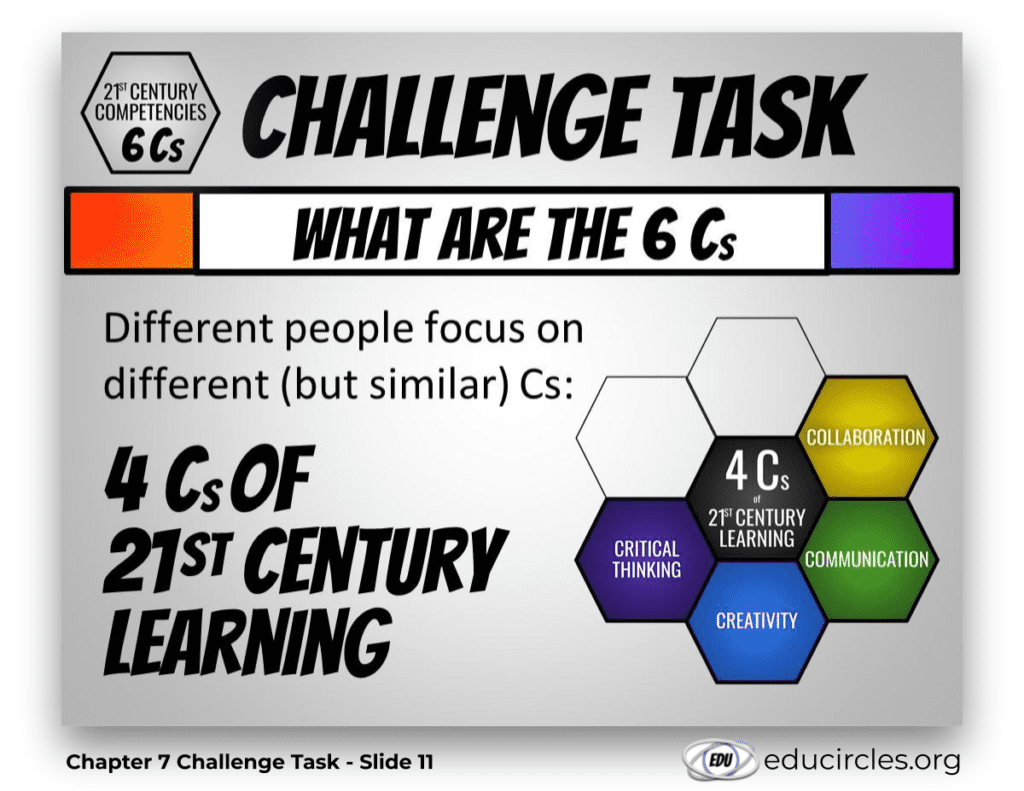
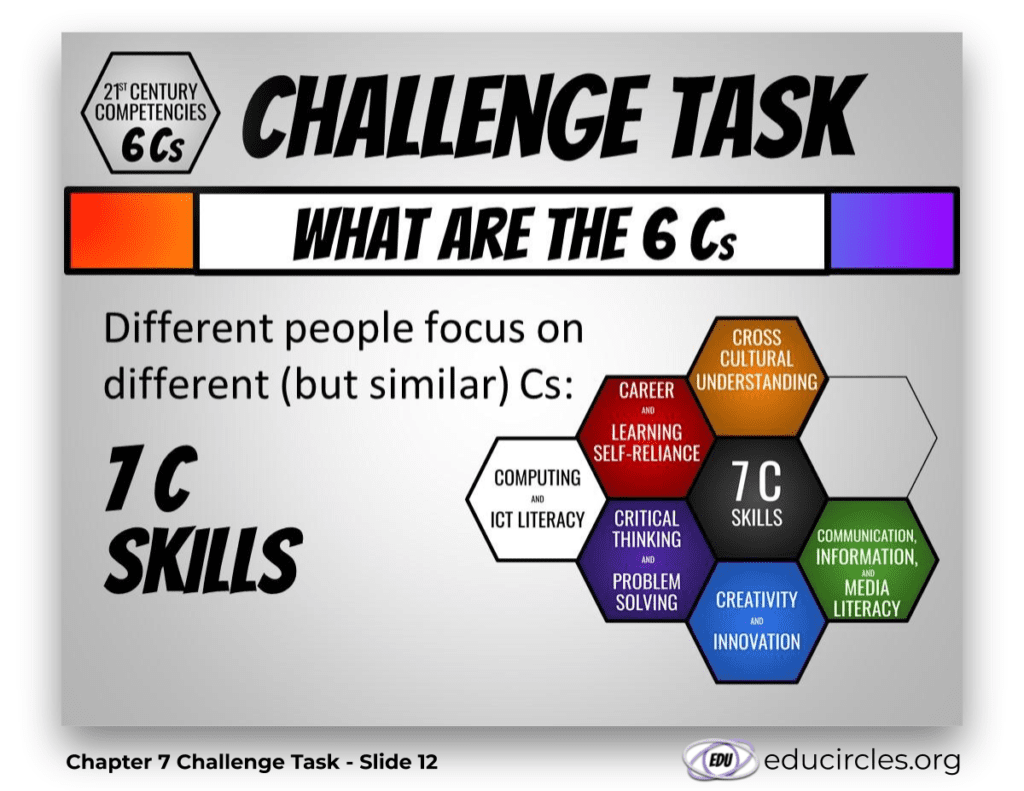
Maybe you talk about 21st Century Skill Clusters (Career and Learning Self-Reliance, Digital Age, Effective Communication, Inventive Thinking, High Productivity)
Or, maybe you just talk about the 6 Cs of Education.
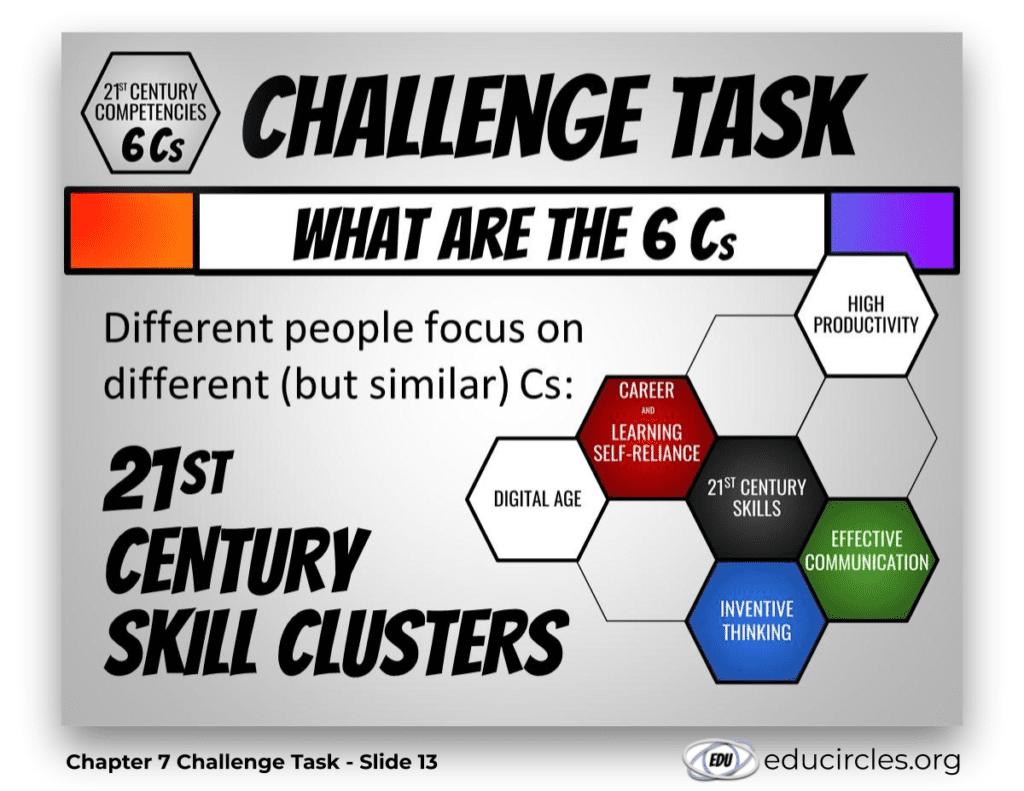
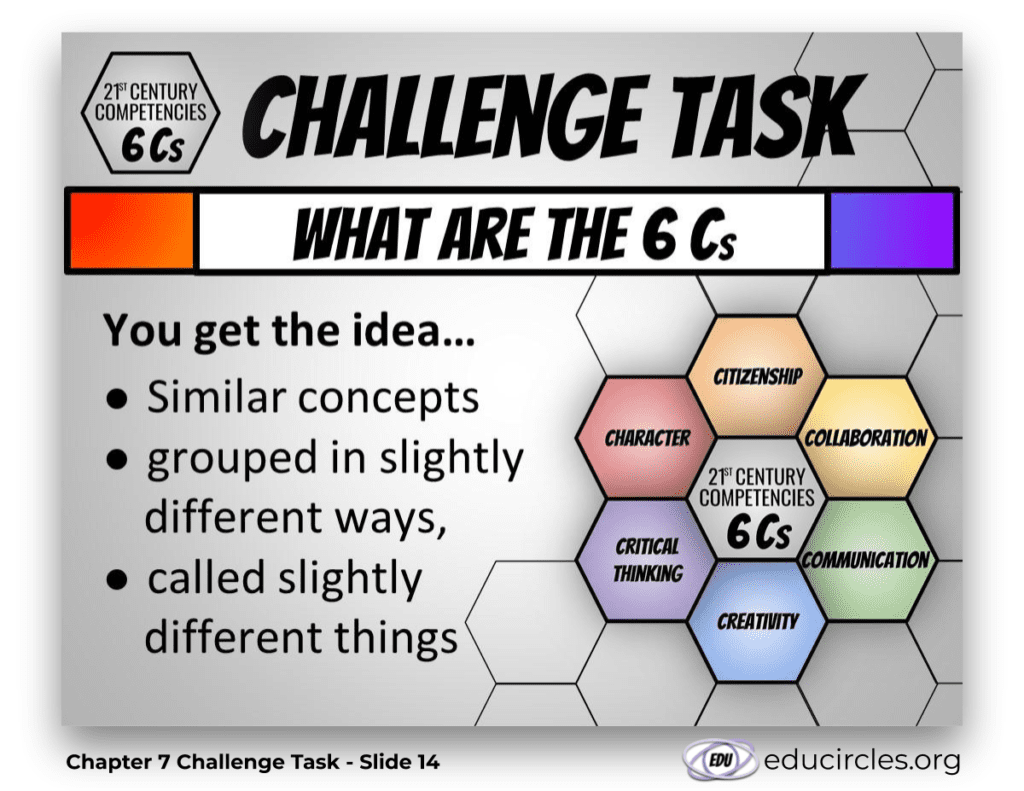
It doesn’t matter if you call them 21st Century skills or 6 C’s of Education…
they’re all about teaching students essential 2021 life skills through our classroom program.
Essentially, the 6 C’s of Education are a bunch of transferable 21st Century competencies that you can use at school, at home, at a job… pretty much anywhere. Now, and in the future.
The world is changing and we need to help our student develop skills, strategies, and a growth mindset that will help them to be successful in the 21st century.
Covid-19 was an unexpected twist that showed how interconnected our world really is. There are no easy solutions to this real-world problem.
But, the reality is there will be other unexpected problems and obstacles. Whether we’re talking about global problems, local problems, or personal problems, I think we can all agree that the future is unknown.
A Growth Mindset is a key component of these 6 Cs. We need to encourage growth mindsets in our students through our lessons as we deliver the curriculum.
What are the 6 Cs of Education?
Here are the 6 Cs of Education:
- Character
- Citizenship
- Collaboration
- Communication
- Creativity (and innovation)
- Critical Thinking
The 6 Cs represent a major paradigm shift in education. (They are also called 21st century skills, 21st Century Competencies, new pedagogies for deep learning.)
Usually when we teach, we focusing on “teaching the curriculum.” We focus on content, knowledge, and what students can memorize.
With the 6 C’s of Education, we focus on skills and attitudes. So, school doesn’t become a place to learn facts. It becomes a place to learn how to live.
Check out my keynote speech about a Paradigm shift in Education.
What can students learn by using the 6 C’s?
These learning skills can be used to explore facts and ideas in the curriculum.
But, the six Cs can also help us in life. Students can learn:
- Subject-based content at school
- How to navigate the relationships in our lives. This includes personal relationships with family. But, it can also include romantic relationships, and how we interact with people at work.
- Ways to achieve our dreams and goals.
- How to deal with change. Covid-19 shut down cities and countries. We never saw that coming!
- to respond to an unfair world like where George Floyd’s death shines a spotlight on systemic racism.
- grit and tenacity to keep going when we face impossible obstacles.
What is NPDL (New Pedagogies for Deep Learning)
New Pedagogies for Deep Learning (NPDL) is a movement to shift the way we teach.
“To foster deep learning so that all learners contribute to the common good, address global challenges and flourish in a complex world.”
Source: New Pedagogies for Deep Learning – a global partnership website https://deep-learning.global/
They are currently in over 1300 schools in 8 countries. NPDL works with “clusters” (networks of schools) to build knowledge and practices that develop deep learning and foster whole system change. (You can read more about it here.)
In other words, the school boards does professional development (PD) with their teachers to try to get teachers to shift the way they teach.
It’s called “DEEP learning” as opposed to the traditional way of memorizing facts and teaching from the textbook.
Like any pedagogical movements, some teachers jump on board right away while others resist change. Because, let’s be honest. Teaching is rewarding, but tough. So much to do with too little time.
I had the opportunity to participate in some NPDL teacher training workshops in the OCDSB.
I love the 6 Cs of Education and NPDL. The 6 Cs helped save my life. ▶️ video
The problem if you’re new to teaching the 6Cs of NPDL is that you have to entirely shift the way you teach to do a “NPDL project”
In the beginning, it becomes an “add-on” to what you’re already doing in the classroom. Something you have to squeeze into your already jam packed program.
Not only do you have to teach a NPDL unit, but you also have to explain the 6 Cs to your students.
That’s where this unit comes in. It helps set the stage for your students to jump into their NPDL project.
- Introduce the concept of the 6 Cs to your class (and have them co-create rubrics for each of the 6 Cs)
- Explicitly give your students time to explore each of the 6 Cs as needed: character, citizenship, collaboration, communication, creativity, and critical thinking.
Now that your students know a little bit about the 6Cs, you have a head start on doing the NPDL project that your school district wants you to “create” and “do”
- With your class / school / cluster / network of teachers come up with your own 6 Cs / NPDL project.
Why am I so passionate about teaching 21st Century Learning Skills (6 C’s)?
Because they helped save my life.
Why we need 21st Century Learning Skills – a case study
I had a mental health crisis when I was a Grade 8 Teacher at Longfields Davidson Heights Secondary School in Ottawa, Canada.
I taught Grade 8 for over 13 years and I loved it. Teaching was my passion. People would ask me when I was going to head down the road and become a principal. The reality is, I loved tinkering in my classroom laboratory and I didn’t want to give that up to become an administrator. Teaching was life.
Then, something happened at my school, and I am no longer fit to teach in the classroom. But, my story doesn’t end here.
My mental health crisis doesn’t end in tragedy. You won’t read about me in the newspapers. (Wait… are there still newspapers? Scratch that. You won’t see me on your news feed…)
I am choosing to write my own narrative and choose my own path.
Part of that path means recognizing that I choose my mindset. I can have a fixed mindset and believe that I can’t change. Or, I can have a growth mindset and as hard as it seems, try to find a way to make the worst moment of my life into the greatest moment.
Thinking, learning and creating lesson plans about 21st Century competencies is helping me to develop skills and attitudes to take the worst moment of my life, and somehow figure out how to turn it into the best moment in my life.
I’m sharing this story with the world because sometimes, when it comes to mental health, we are surrounded by a single story of violence and tragedy.
We get a skewed view of reality because we are bombarded by sensational stories – in the media, on social media, and sometimes, even in school plays.
Novelist Chimamanda Adichie talks about the danger of a single story in her TED talk. We create a single story when we
“…show a people as one thing, as only one thing, over and over again, and that is what they become… The single story creates stereotypes, and the problem with stereotypes is not that they are untrue, but that they are incomplete. They make one story become the only story.”
Chimamanda Ngozi Adichie, The Danger of a Single Story
It is often easier to talk about physical health than mental health. It’s easier to talk about our daughter breaking her leg while playing hockey rather than talking about our son who has depression and attempted suicide.
So, then, we don’t share our stories about mental health. Our stories of struggle, our stories of resilience, and our stories of accepting a new normal.
In the silence, then, the only stories we do hear about are about shootings, suicide, and tragedy.
The reality is, we need a balance of stories.
Ultimately, we need to reject the single story that extreme bullying leads to extreme violence and that mental health crisis leads to tragedy.
I share my story of struggle in the hopes that it helps someone else get through theirs.
There’s never a good time to stand up and be counted. But, I posted my video about what happened to me during Mental Health Awareness Month. I wanted to take the opportunity to get real and get loud about mental health .
- 0:00 – Warning. This video discusses depression and violence. It may not be appropriate for all viewers.
- 0:42 – What is Mindset? Fixed Mindset vs #GrowthMindset
- 2:00 – Four levels of strategies
- 4:47 – 21st Century Learning Competencies / Skills
- 5:35 – We are surrounded by a single story of violence
- 5:53 – What happened to me at LDHSS
- 9:51 – We need a balance of stories. Why we need to get real and get loud about mental health
The thing about school is that we create a learning environment where if you have a question, you raise your hand and someone gives you the answer.
So, what do our students do when they finish school and have to figure out the answers to open-ended problems where no one knows what the best answer is?
And, that’s why we need to embed 21st Century Learning Skills into our classroom programs.
So our students can take these transferrable skills and attitudes and apply them to un-googleable problems.
90 lessons to help teachers explore the 6Cs of Education and teach transferable 21st Century Learning Skills
This unit is not designed to replace all of the hard work that you’ll have to do in your class and school. Discovering how to incorporate 21st Century Global Competencies into the DNA of your lessons is an ongoing process.
Instead, these 90 lessons are a starting point for conversation.
You can modify, edit, adapt all of the materials.
Each Chapter package focuses on a different “C” and contains different lessons, slides, videos, and handouts.
Although I’ve used the same structure in each chapter (activity, video, consolidation / vocabulary building), there is no overlap of content between the 6 Cspackages.
Lessons can be purchased individually, or you can purchase the entire unit at a discount. Visit the Educircles TpT store for more information.
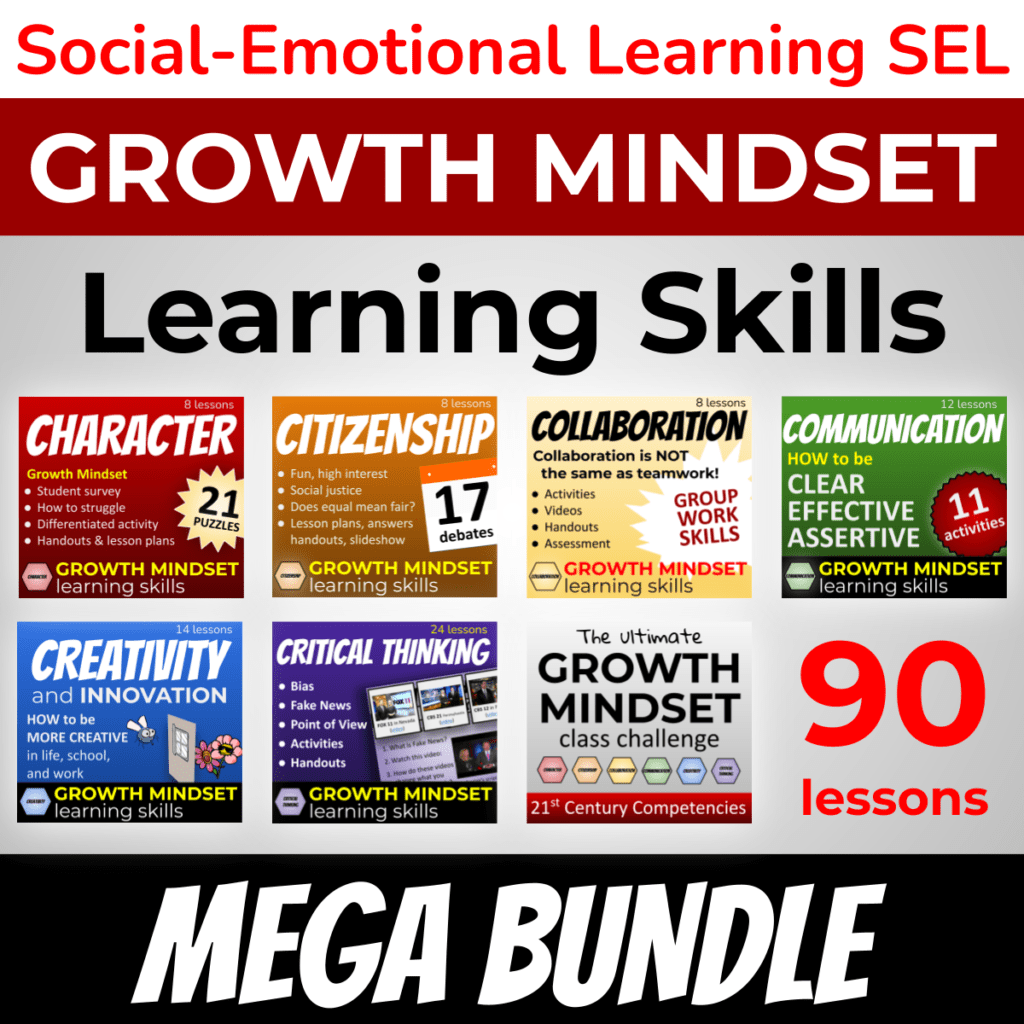
- Unit Overview
- Intro: Fun Ice Breakers
- Chapter 1. Character (8 lessons)
- Chapter 2. Citizenship (8 lessons)
- Chapter 3. Collaboration (8 lessons)
- Chapter 4. Communication (12 lessons)
- Chapter 5. Creativity (14 lessons)
- Chapter 6. Critical Thinking (24 lessons)
- The Ultimate Growth Mindset Class Challenge (16 lessons)
- MEGA BUNDLE (all of the above and more)
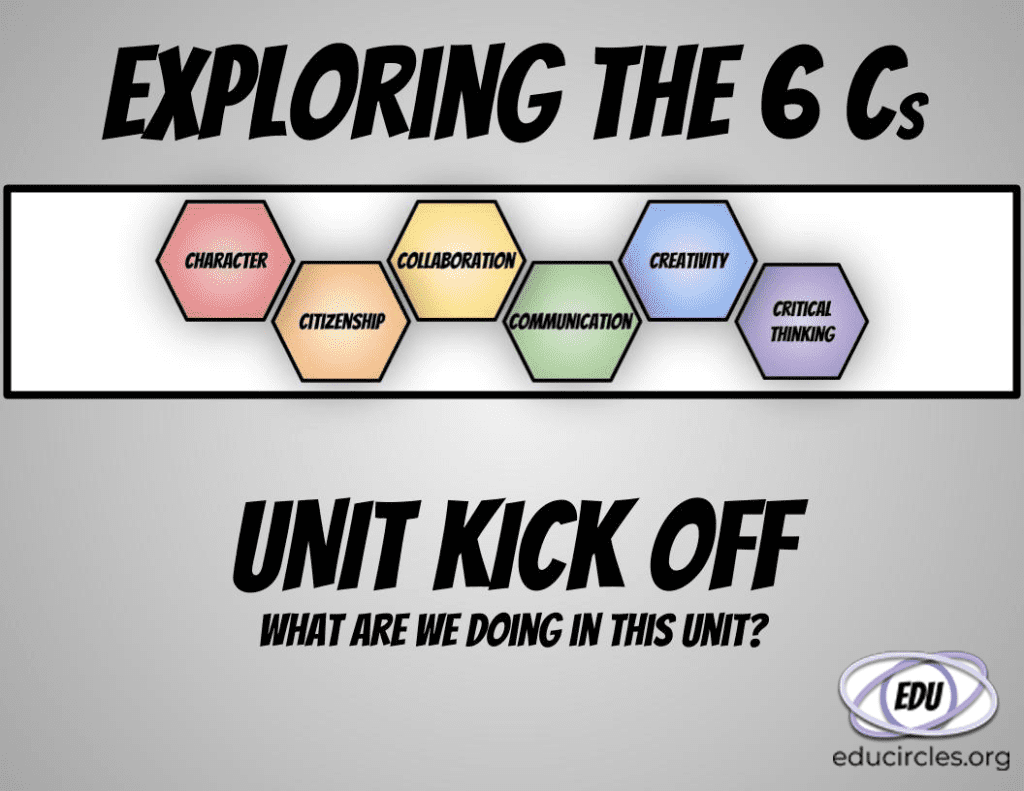
Exploring the 6 Cs of Education Unit – Overview Lesson Plan
Exploring the 6 Cs of Education is a great way to kick off the new school year or school term.
UNIT BIG IDEA
By the end of this unit, students will be able to
- Understand / Explain the 6 Cs of Education and Deep Learning (Learning Skills):
- Analyze the similarities and differences between the 6 Cs of Education.
- Analyze how the 6 Cs are interconnected but separate at the same time. (Compare and contrast.)
CURRICULUM LINKS
The six Cs are a great way to connect to character education and learning skills.
Depending on where you teach, you may be able to connect it to the English Language Arts curriculum as well. Some possible connections to the Grade 8 Language Arts Ontario Curriculum are made below to give you ideas:
- Oral Communication (from the activities / think / pair / share conversations)
- Active Listening Strategies (ONT LA 1.2): demonstrate an understanding of appropriate listening behaviour by adapting active listening strategies to suit a wide variety of situations, including work in groups (e.g. follow the conversation and make relevant contributions in a group discussion…)
- Media Literacy (from discussing videos about the 6 Cs)
- Making Inferences / Interpreting Messages (ONT LA 1.2) Interpret increasingly complex or difficult media texts, using overt and implied messages as evidence for their interpretations.
- Writing (from vocabulary builder graphic organizer used to play with word meanings)
- Vocabulary (ONT LA 3.3): Confirm spellings and word meanings or word choice using a variety of resources appropriate for the purpose.
MATERIALS
- PowerPoint slideshow
(Make sure required fonts are installed or it may look weird. See Read Me note for help.)
LESSON PLAN
UNIT OVERVIEW (slides 1, 2)
In the next unit, we’re going to be exploring something called the six “C’s.
The 6 Cs are a bunch of skills that you can use at school, at home, at a job… pretty much anywhere.
They’re learning skills that some people think you’re going to need to be successful in the 21st century.
This year, you’re going to be learning a lot of stuff in class. You’re going to be learning about English, Math, Science, Geography, Phys Ed, Art, Music, etc etc.
- The provincial / state curriculum tells us what you’re going to learn at school.
- The 6 Cs are about HOW to learn and do things.
The 6 Cs are things that everyone can do and should do. And, if you can start to learn and develop these skills at school, you’ll find you can apply them at home, in relationships, now, and in the future.
Today’s lesson is just an overview of what we’re going to be doing for the next few weeks. I’m going to give you a road map so you know where we’re headed. (Sometimes, if students know what they’re going to be learning, it helps them to put things together.)
Each of the “C”s is in one of these hexagon icons. (Get it? 6 Cs… six sides… hexagon…)
- Character (RED)
- Citizenship (ORANGE)
- Collaboration (YELLOW)
- Communication (GREEN)
- Creativity (BLUE)
- Critical Thinking (PURPLE)
In this unit, I’ve colour coded the hexagons. Pssst. Think rainbow.
- Actually, the rainbow metaphor is kind of cool because white light is composed of different colors: red, orange, yellow, green, blue, violet.
- And, just like white light, if you combine all 6 Cs, all of these learning skills, you’ll find that you can see better and do better.
- It’s easier to do things if you’re not running around in the dark.
You’ll notice there’s a lot of overlap between the 6 Cs and activities in this introduction. That’s because they’re all interconnected.
- It doesn’t really matter which “C” we start with but just for fun, we’re going to go alphabetically and spend some time looking at each “C”.
- You might find that when we do an activity, it reminds you of a different “C” than the one we’re focusing on. That’s ok. You can do one activity and find different “C”s that connect with it.
Teacher Tip: So, if your class has a favourite activity, feel free to use it again but with a different conversation focus.
Big Picture (slides 3, 4)
Here’s the big picture for what we will be learning in this unit.
Each “lesson” may take one class, or several classes, depending on the class, how interactive they are, and how long the periods are.
- For example, “Lesson 1” might take 6 classes – one class for each “C”.
- TEACHER TIP: You can switch around the order of the 6 Cs to meet your needs, or your school learning plan.
Lessons 2-7 look at each “C” one by one and each lesson has 3 parts: an activity, a video, and a vocabulary worksheet. Each of these parts could easily be a class onto itself.
At the very end, there is a review.
- TEACHER TIP: You can add an assessment component to this, if you like.
The first lesson is an overview of all 6 Cs. We will be doing an activity for each C to give you a taste of what that C is about.
Your job as we go through each C is to think about
- What each C has in common? (So, what does “character have in common with citizenship”?)
- How the Cs are different from each other? (So, what’s the difference between “collaboration” and “communication”?)
Lesson structure: experience, watch, understand each of the 6 Cs (slides 5,6)
The next six lessons give you a deeper understanding of each “C” one at a time.
Each lesson actually has 3 parts and all of the lessons follow the same format:
- The first part is to experience the “C” (so, creativity, critical thinking, etc.)
- The second part is to watch the “C”
- And the last part is to develop a deeper understanding of the “C”
What does this actually mean?
During the first part, we’re going to do an activity that helps us experience that “C”
We do this because some of the Cs are hard to explain. (Like what’s the difference between collaboration and communication.)
So, an activity can help us figure out what the word means. (Like, I kind of know what critical thinking is… but, wait, what’s the difference between just regular thinking and “critical” thinking?) So, the activity gives us an idea of what the “C” is all about.
Next, we’re going to watch a video.
- Sometimes, seeing a video clip helps us to figure out what the concept is.
- Different people learn in different ways, so this might help some of us to get a better understanding of that “C”
Finally, we’re going to play with the word to get a really good understanding of what the “C” is all about.
We’re going to use a graphic organizer to …
- play with our understanding of the “C” by brainstorming facts about the topic,
- clarify our understanding of the word by coming up with non-examples, and then
- communicate a more concise understanding of what the “C” means…
- and figure out which characteristics are the most essential to the “C” …
At the very end, we’re going to review the question we asked at the very begin with the introduction lesson:
- What do the 6 C’s have in common?
- How are the 6 C’s different from each other?
In other words, how are they interconnected with each other, but really separate at the same time?
Some very smart people in the world came up with these 6 C’s. (Not me) These are the skill sets they think we need to survive and thrive in the 21st century – anywhere in the world.
So, even though there are times when it seems like the Cs are the same thing (like communication and collaboration), it’s our job during this unit to try to figure out how they’re similar, but different at the same time.
The last unit is going to be an overview and review.
TEACHER TIP: You may choose to do an assessment at the end.
LESSON PLAN – REVIEW QUESTIONS
Let’s recap and see if you were paying attention!
1. What are the 6 “C”s?
- Character, Citizenship, Collaboration, Communication, Creativity, and Critical Thinking.
- Bonus question: Does the order matter? (No. Most activities can connect with multiple Cs, but we’re doing them in alphabetical order just for fun / to have structure to this unit.)
2. What is the guiding question we need to think about as we go through the mini lessons on the 6 “C”s?
- Similarities and differences between the 6 C’s.
3. What are the three parts of each mini lesson?
- Activity to experience the C.
- Watch a video to learn about the C in a different way
- Play with the word using a graphic organizer to get a better understanding of the C.
4. Why do three different things?
- Different people learn in different ways. So, the first way is active / kinesthetic, the second way is visual, and the third way is logical / verbal.
5. What is the review question that we’ll use to reflect back on the unit?
DOWNLOAD THIS RESOURCE: (FREE) Exploring the 6 Cs Unit Overview Lesson
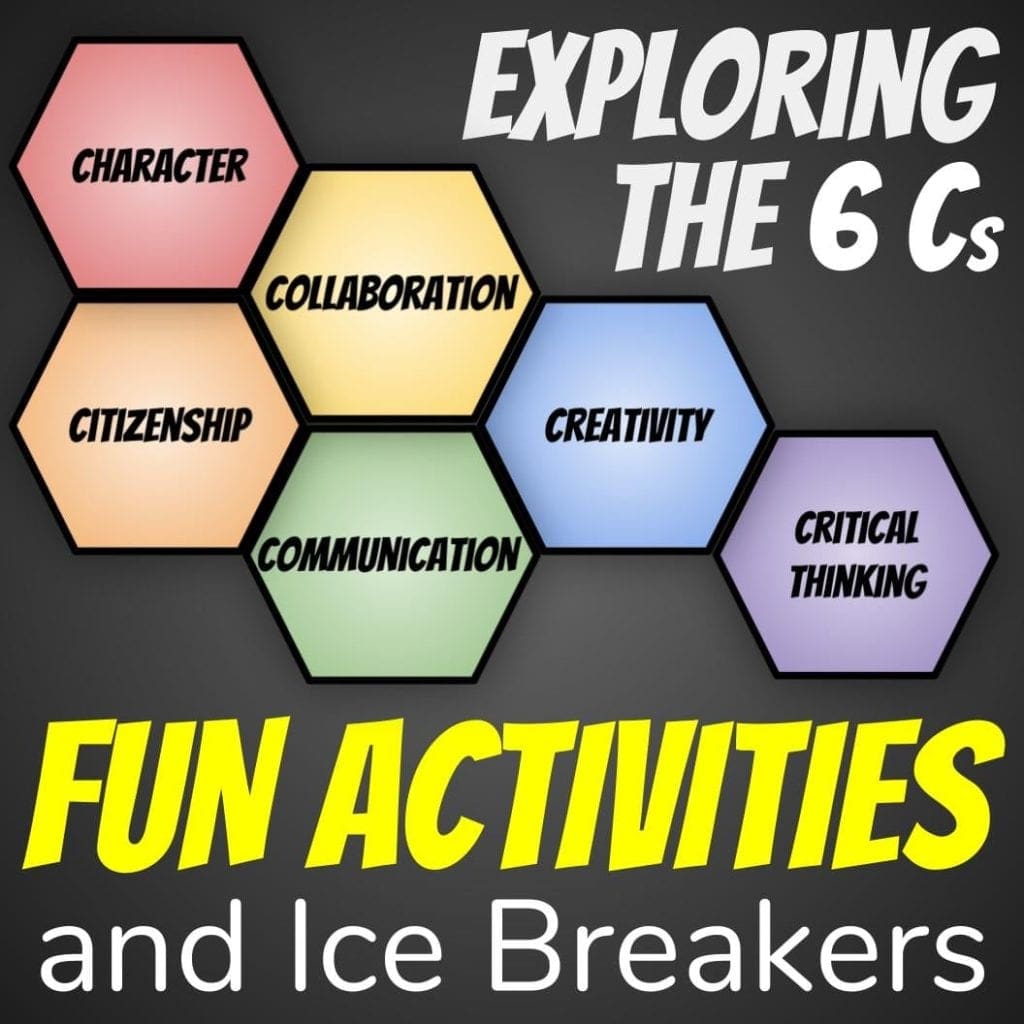
Exploring the 6 Cs – Lesson 1 Fun Activities and Icebreakers Intro
This lesson is a great way to introduce the 6 Cs of Education learning skills to your students and to set the tone for a year of growth mindset and perseverence:
The 6 Cs are a bunch of transferable skills that you can use at school, at home, at a job… pretty much anywhere. They’re learning skills that some people think our students are going to need in order to be successful in the 21st century.
This lesson includes 6 fun icebreakers to play with your class during the first weeks of school.
In this package, you get over a week’s worth of lessons to do (6 periods of material). Each ice breaker is intended to fill one period of instruction. Each icebreaker lesson includes:
- an explanation for teachers of how the icebreaker connects to one of the 6 C’s.
- a description of the activity for students,
- discussion questions and teacher talking points to guide conversation
Here are the six icebreakers we carefully selected to line up with the 6 Cs of Education.
- Character (Human Knot)
- Citizenship (Switch Spots if you…)
- Collaboration (Human Shapes)
- Communication (Line Up)
- Creativity (Boggle Brainstorm)
- Critical Thinking (Build a Tower)
There are lots of ways you could use these 6 Cs Introduction Icebreakers with your students:
- Homeroom teachers could do one of these activities at the end of every day during the first week of September.
- Literacy teachers could do these activities at the start of the term and collect some diagnostic information about their students abilities in oral communication and group work.
- Your school could organize a fun Welcome New Year New You event.
- At a morning assembly, after the Principal welcomes back the students, do the Six C unit overview presentation to introduce the 6 Cs to the student body. (The Unit Overview lesson is provided for free here: https://educircles.org/resources/exploring-the-six-cs-unit-overview-lesson/
- Students could then visit 6 workshop stations throughout the day.
- Each workshop would focus on one of the 6 Cs and could use the icebreakers from this package.
- The teacher running the workshop would use the lesson plan to teach the “C” to different groups of students throughout the day. (Using the lesson plan from this package means teachers don’t have to prepare anything new for the first day event. All of the materials will be provided to them. That way, they can focus on preparing their material for their own classes.)
- During the rest of the week, literacy teachers or homeroom teachers could do deeper conversations of the 6 Cs with their classes. (But, a consistent and systematic initial overview of the 6 Cs would be provided to all students on the first day.)
When you download the zipped file, it includes:
- A Microsoft Powerpoint (PPT) file (that you can modify)
- A link to the Google Slideshow file (that you can copy and modify)
- A 23 page lesson plan (PDF)
NOTE: This lesson is part of a larger unit.
- The Unit Overview is free and part of Lesson 1 (Character Ice Breaker) is free so you can see the quality of our work.
- The other lessons can be purchased individually, or you can purchase the entire unit at a discount.
Here’s the entire Exploring the 6 C’s Unit
- Unit Overview (FREE)
- Lesson 1. Intro Ice Breakers (THIS LESSON)
- Lesson 2. Character
- Lesson 3. Citizenship
- Lesson 4. Collaboration
- Lesson 5. Communication
- Lesson 6. Creativity
- Lesson 7. Critical Thinking
- Lesson 8. Review / Assessment / Compare and Contrast the 6 Cs
WANT a FREE PREVIEW of this lesson plan before you buy it?
What does this mean?
- It means you get the first part of this paid resource for free (Character ice breaker lesson plan and slideshow) so you can see the quality of our work.
- We’ve blurred out the rest of the resource in this preview because we think you’ll like what you see and you’ll want more.
Why are we doing this free preview?
- Because some teachers are nervous about buying online resources. They’re not completely sure they’re getting their money’s worth. Everything in this zipped file is exactly the same as the paid version… What you see is what you get… except the paid version isn’t blurry!
- Because you don’t know me. I don’t teach down the hall from you, so you don’t know the kind of teacher I am. This gives you a chance to see the passion and care that went into this lesson. Quite frankly, this is a cool slideshow. And the discussion questions are awesome.
- Why don’t you give away the entire resource for free? That is an excellent question! Read our response: https://educircles.org/why-dont-you-give-away-everything-for-free/
Where can I buy the full resource?
This resource (and others like it) can be downloaded from our Teachers Pay Teachers download site (We sell on TpT) (We sell on TpT).

Exploring the 6 C’s – Lesson 1. Intro Ice Breakers – FREE LESSON PLAN version
Let’s get excited about the 6 C’s.
- This introduction is supposed to be a taste of the different sections.
- The point of this lesson is to do some fun activities that are connected to each “C”, but without spending a lot of time explicitly going into deeper conversations and definitions. (We’ll do that later in the next 6 lessons on each individual C.)
LESSON GOAL
- Bring everyone together in ice-breaker style activities – co-operative group / team activities.
- Recognize that the 6 C’s are interconnected, yet separate – there’s a fine line between all of them.
TEACHER TIP: You’ll notice throughout the activities there are lots of photo opportunities for those of you who send home parent emails.
CONNECTING TO THE UNIT BIG PICTURE:
By the end of this lesson, students will be able to start to
- Understand / Explain the 6 C’s of Education and Deep Learning (Learning Skills):
- Character,
- Citizenship,
- Collaboration,
- Communication,
- Creativity, and
- Critical Thinking.
- Analyze the similarities and differences between the 6 C’s.
(Possible) CURRICULUM LINKS in this lesson
The 6 C’s are a great way to connect to character education and learning skills. Depending on where you teach, you may be able to connect it to the English / Language Arts curriculum as well. Some possible connections to the Grade 8 Language Arts Ontario Curriculum are made below to give you ideas:
- Oral Communication (from the activities / think / pair / share conversations)
- Active Listening Strategies (ONT LA 1.2): demonstrate an understanding of appropriate listening behaviour by adapting active listening strategies to suit a wide variety of situations, including work in groups
MATERIALS
- PowerPoint slideshow or Google Slides Presentation
(Download from zipped file. See Read Me note for help.) - Ice Breaker Activity #5 Creativity – Boggle Brainstorm
- Students need to write in their groups. (Class divided into groups of 2-3 students)
- Option 1. Student provides their own paper and pencil
- Option 2. Teacher provides 1 flipchart and 1 marker (per group)
- Students need to write in their groups. (Class divided into groups of 2-3 students)
- Ice Breaker Activity #6 Critical Thinking – Tallest Free Standing Tower
- Newspapers (or flipchart paper, or other large paper you have at your school)
- Masking Tape
Introduction
What are the “6 C’s”? Does anyone remember from last class?
The order doesn’t really matter, because they’re all kind of connected. But just to help organize our thoughts, we’ve colour coded the 6 C’s and put them into alphabetical order…
- Character (RED)
- Citizenship (ORANGE)
- Collaboration (YELLOW)
- Communication (GREEN)
- Creativity (BLUE)
- Critical Thinking (VIOLET)
Minds On!
As we explore each “C” of Education today, the big question is can you figure out
- What they have in common?
- How are they different from each other?
The point of this lesson is to get a sense of these transferable skills.
- Remember, these are “21st century skills” – they can help us learn in the classroom, work with other people, and overcome challenges in life.
- They’re called “transferable” skills because you can “transfer” these skills from the classroom, to your job, to your personal life, etc.
MINDS ON:
Before we do some activities, lets start to think about these hexagons.
If you could move these hexagons around and group them together…
- Which of these 6 C’s do you think go together? (i.e. at first glance, they look like they mean the same thing, or they have a lot of similarities.) Why would you group them together?
- Which of these 6 C’s do you think are opposites or completely different?
At this point, there’s no right or wrong answer. The goal is to get students to start to think about connections between the 6 C’s, instead of only thinking about them in isolation…
Sample teacher prompts:
What do you think collaboration is?
- How is collaboration similar to communication?
- Are there any differences between Collaboration and Communication?
What do you think “Character” is? Can you explain what Citizenship means?
- Character and citizenship have a lot in common. What might be some similarities between the two?
- How is Character different from Citizenship?
What is “Creativity”? What do you think “Critical Thinking” is?
- How might creativity and critical thinking be similar?
- What could be the major difference between the two?
TEACHER TIP: You could do this as a “think, pair, share” activity.
- Ask the question and give students 30 seconds to silently and independently think about the answer.
- Next, turn to their elbow-partner or get into groups of 2-3 and share answers.
- Finally, facilitate a whole-class conversation where students raise their hands and share what their little group was discussing.
ICE BREAKER ACTIVITY – 1. Character
The first “C” we’re going to look at is “Character.”
MINDS ON: Similarities & Differences. (Two minute quick conversation)
- What do you think “Character” is? Why? What does “Character” look like?
- Which “C” do you think “Character” is going to be most similar to? Why?
- Which “C” do you think “Character” is going to be very different from? Why?
(Student answers will vary. The goal is to start figuring out similarities and differences.)
ACTIVITY: Human knot
BASIC IDEA:
- Students stand in a circle and hold hands with two different people on the other side. Their group then has to untie the “human knot” without letting go.
Why did we choose this activity for “Character”?
- Human Knot is a great icebreaker because it gets students moving and interacting with their fellow classmates.
- There is a little element of competition because the class is divided into two groups trying to unravel the human knot.
- Inevitably, the groups don’t want to “fail” (and not unravel the knot.) Also, most groups want to be “first” to win.
However, this is more than an ice-breaker. It’s an opportunity to demonstrate perseverance and character.
- After the teacher gives out general instructions and the groups start to try to untangle, it’s important for the teacher not to suggest solutions or be the enforcer of rules. (Of course, common sense dictates and teachers know their students best and will act to ensure students are safe. Depending on the grade, more or less support might be required.)
- The real question is what do people do when we’re faced with adversity and frustration because we can’t untangle the knot…
- Do we encourage others? Are we problem solving? As we find ways to put things in perspective, are we able to stay positive?
- Do we blame others? Are we tempted to just cheat? Do we give up easily when things get tough?
- What does success mean?
Get into 2-3 even groups.
- Generally speaking, this works best by splitting the class into 2 groups, because if you lose, it’s okay because so did half the class. (If you have a lot of smaller groups, one of the groups might feel bad for losing.)
- Having said that, in a class of 36 students, a human knot of 18 people might be physically impossible. Then again, maybe not.
Each student hold hands with someone who isn’t beside them.
- This is important, because otherwise, it’s easier to solve the knot if you’re holding your elbow-partner’s hand.
- Students need to make sure they’re connected to different people, otherwise they might splinter off into multiple tiny knots. (This may happen anyway if 3 friends end up holding each other’s hands.)
How quickly can you untangle the knot without letting go?
TEACHER TIP: A stopwatch can create some fun competition.
SAFETY FIRST
- Your students may need reminders about going slowly and respecting classmates to make sure people don’t get pulled or hurt by accident.
- Depending on the age of the group, you might need a rule that it’s okay to let go and reconnect with the same hand so that people don’t get hurt. Having said that, we’ve seen some spectacular problem solving when we’ve told older students not to let go and reposition their hand, but instead to move slowly.
CULTURAL SENSITIVITY AND PERSONAL SPACE
- You know your students best in terms of how this activity might need to be modified or constructed to ensure everyone has a positive and inclusive experience.
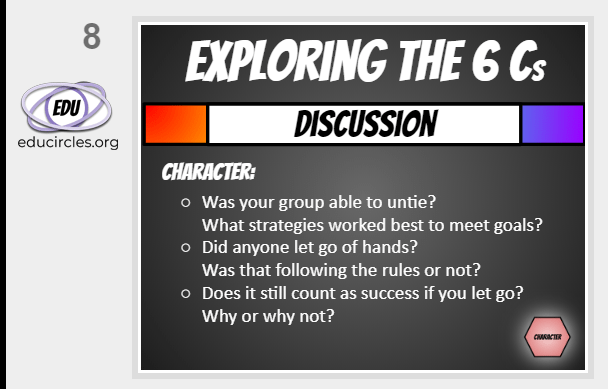
TALKING POINTS: Character
Groups may not be able to untie, and that’s okay. The important conversation is about what strategies did they try? What worked or didn’t work? Next time, what could they try to do differently?
- Let’s explore this idea of cheating? Does it count as a win, if you cheat? Is there ever a time when it’s okay to cheat?
- Part of character is the ability to show persistence in the face of difficulty. What do you do when things get tough?
- But part of character is also having the empathy to understand yourself, and others. Is it important to untie the knot – even if it means someone is not having fun, or is getting pulled along
- How do we find and develop strategies to meet our goals?
After this discussion, if time permits, try again.
- Groups can stay the same, to try different strategies to see if they can beat their previous time.
- or groups can be switched up to try different interactions and strategies.
- Or try an entire class human knot and see what happens.
(OPTIONAL) DEBRIEF Similarities & Differences. (Two minute quick conversation)
Depending on your class and amount of time you have in class, some teachers will choose to skip the debrief to keep things moving and fast paced. Other teachers might take the time to debrief the activity and reconnect with the big question about similarities and differences between the 6 C’s.
- Based on this activity, what do you now think “Character” means?
Now that we’ve done this activity, has your answer changed to the following questions:
- Which “C” do you think “Character” is going to be most similar to? Why?
- Which “C” do you think “Character” is going to be very different from? Why?
ICE BREAKER ACTIVITY – 2. Citizenship
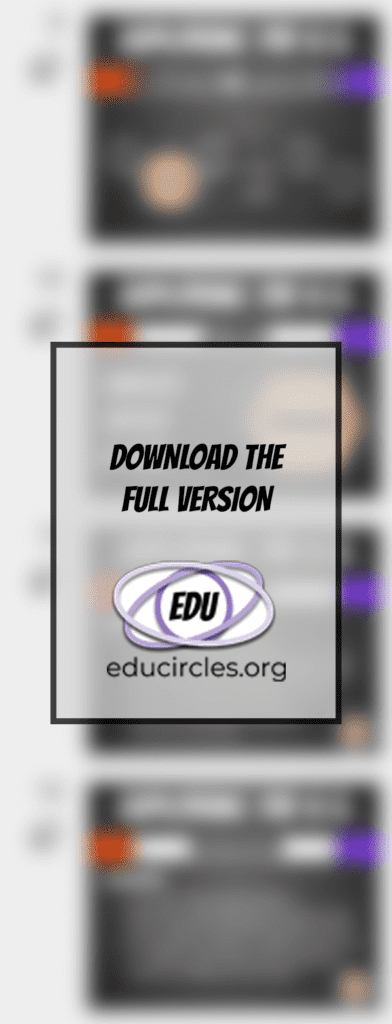
DOWNLOAD THE FULL VERSION to unlock this activity.
ICE BREAKER ACTIVITY – 3. Collaboration
DOWNLOAD THE FULL VERSION to unlock this activity.
ICE BREAKER ACTIVITY – 4. Communication
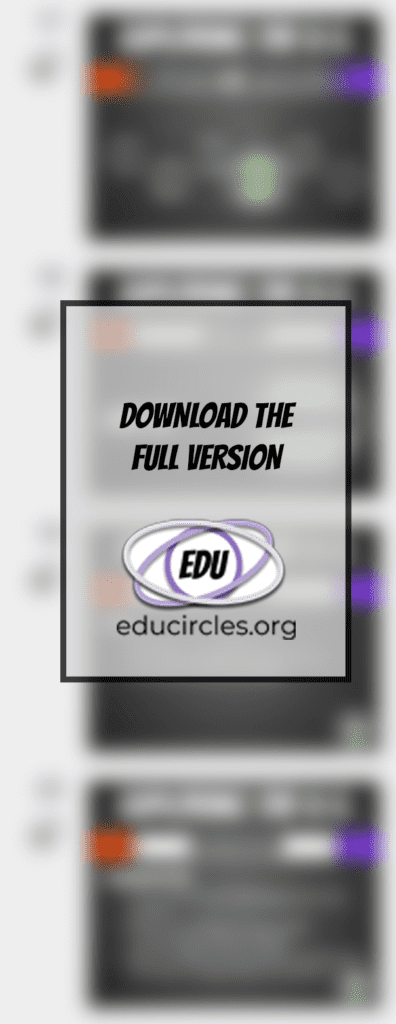
DOWNLOAD THE FULL VERSION to unlock this activity.
ICE BREAKER ACTIVITY – 5. Creativity
DOWNLOAD THE FULL VERSION to unlock this activity.
ICE BREAKER ACTIVITY – 6. Critical Thinking
DOWNLOAD THE FULL VERSION to unlock this activity.
ICE BREAKER ACTIVITY – Debrief / Discussion
DOWNLOAD THE FULL VERSION to unlock this activity.
